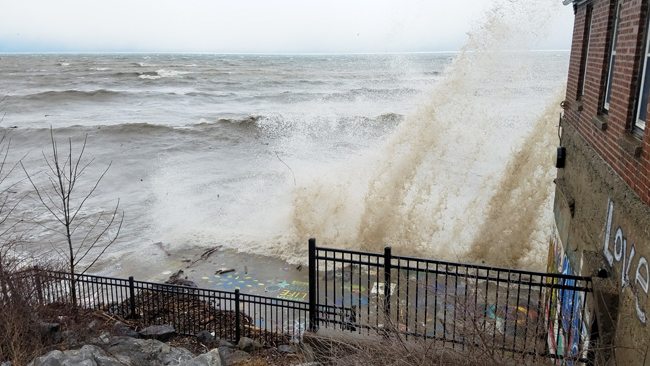Contacts:
Roy Widrig, Great Lakes Coastal Processes and Hazards Specialist, E: rlw294@cornell.edu, P: (315) 312-3042
Kara Lynn Dunn, NYSG's Freelance Great Lakes Publicist, E: karalynn@gisco.net, P: (315) 465-7578
Are you vulnerable? How to prepare?
Buffalo, NY, February 28, 2022 — New York Sea Grant, in collaboration with the University at Buffalo, has published a “Seiche Events on Lake Erie” factsheet (pdf) to help shoreline property owners and managers better respond to erosion and potential hazards associated with seiches.
The factsheet offers steps that property owners can take to know if their shoreline area is susceptible to seiche impact and ways to protect land and buildings.
A seiche, pronounced “saysh,” is a prolonged standing wave oscillating through a body of water. Lake Erie is known for seiche events due to its east-west orientation, shallow depth, and dominant wind direction.
Seiche impact can cause localized coastal flooding, rapid and intense erosion of the shoreline, and dangerous rip currents. The most destructive documented seiche in Western New York occurred in Buffalo in October 1844 with the loss of 78 lives.
“Seiche events occur every one to two years on Lake Erie, with recent events causing intense shoreline erosion in low-lying coastal areas from Hamburg to Van Buren Point near Fredonia, New York,” said Roy Widrig, a Coastal Processes and Hazards Specialist with New York Sea Grant, and co-author of the “Seiche Events on Lake Erie” fact sheet.

Seiche waves strike a shoreline structure in Buffalo, New York, in April 2018. Photo: NYSDEC
Climate change has a role in the frequency of seiches.
“Based on climate change projections, the risk of onshore impact from seiche events may worsen in the future along Lake Erie as the lake becomes less likely to ice over,” said fact sheet co-author Kendra Vorenkamp, a Ph.D. candidate and researcher with the Department of Civil, Structural and Environmental Engineering at the University at Buffalo.
“More frequent windstorms and intensified thunderstorms as well as the lack of ice along the shoreline in winter from climate change may create conditions conducive for more frequent seiches,” said Widrig.
New York Sea Grant provides free evaluation of property for shoreline erosion and flooding hazards through its Virtual Site Visit portal at www.nyseagrant.org/glcoastalvirtualsitevisit. Widrig can also be reached at 315-312-3042.
The New York State Department of Environmental Conservation was a “Seiche Events on Lake Erie” fact sheet project collaborator, with funding provided by the New York State Environmental Protection Fund under the authority of the New York Ocean and Great Lakes Ecosystem Conservation Act. Stony Brook University and the Lake Erie Watershed Protection Alliance provided project assistance.
More Info: New York Sea Grant
New York Sea Grant (NYSG), a cooperative program of Cornell University and the State University of New York (SUNY), is one of 34 university-based programs under the National Oceanic and Atmospheric Administration’s National Sea Grant College Program.
Since 1971, NYSG has represented a statewide network of integrated research, education and extension services promoting coastal community economic vitality, environmental sustainability and citizen awareness and understanding about the State’s marine and Great Lakes resources.
Through NYSG’s efforts, the combined talents of university scientists and extension specialists help develop and transfer science-based information to many coastal user groups—businesses and industries, federal, state and local government decision-makers and agency managers, educators, the media and the interested public.
The program maintains Great Lakes offices at Cornell University, University at Buffalo, SUNY Oswego and the Wayne County Cooperative Extension office in Newark. In the State's marine waters, NYSG has offices at Stony Brook University and Cornell Cooperative Extension of Nassau County on Long Island; at Brooklyn College, with New York City Department of Environmental Protection in Queens and at Cornell Cooperative Extension in NYC and Elmsford and Kingston in the Hudson Valley.
For updates on Sea Grant activities: www.nyseagrant.org has RSS, Facebook, Twitter, Instagram, and YouTube links. NYSG offers a free e-list sign up via www.nyseagrant.org/nycoastlines for its flagship publication, NY Coastlines/Currents, which is published quarterly.